Hellenistic Art Quiz
1/69
There's no tags or description
Looks like no tags are added yet.
Name | Mastery | Learn | Test | Matching | Spaced |
|---|
No study sessions yet.
70 Terms
Kolossos of Rhodes
massive bronze statue (more than 100 ft tall) of Helios, ca. 290 BCE by Chares of Lindos. inscriptions note the raised arm, may have held fire, wore crown with the rays of the sun. Statue no longer exists. earthquake in 266 BCE, statue fell and was slowly picked apart until 7th century. one of the 7 wonders of the Ancient World
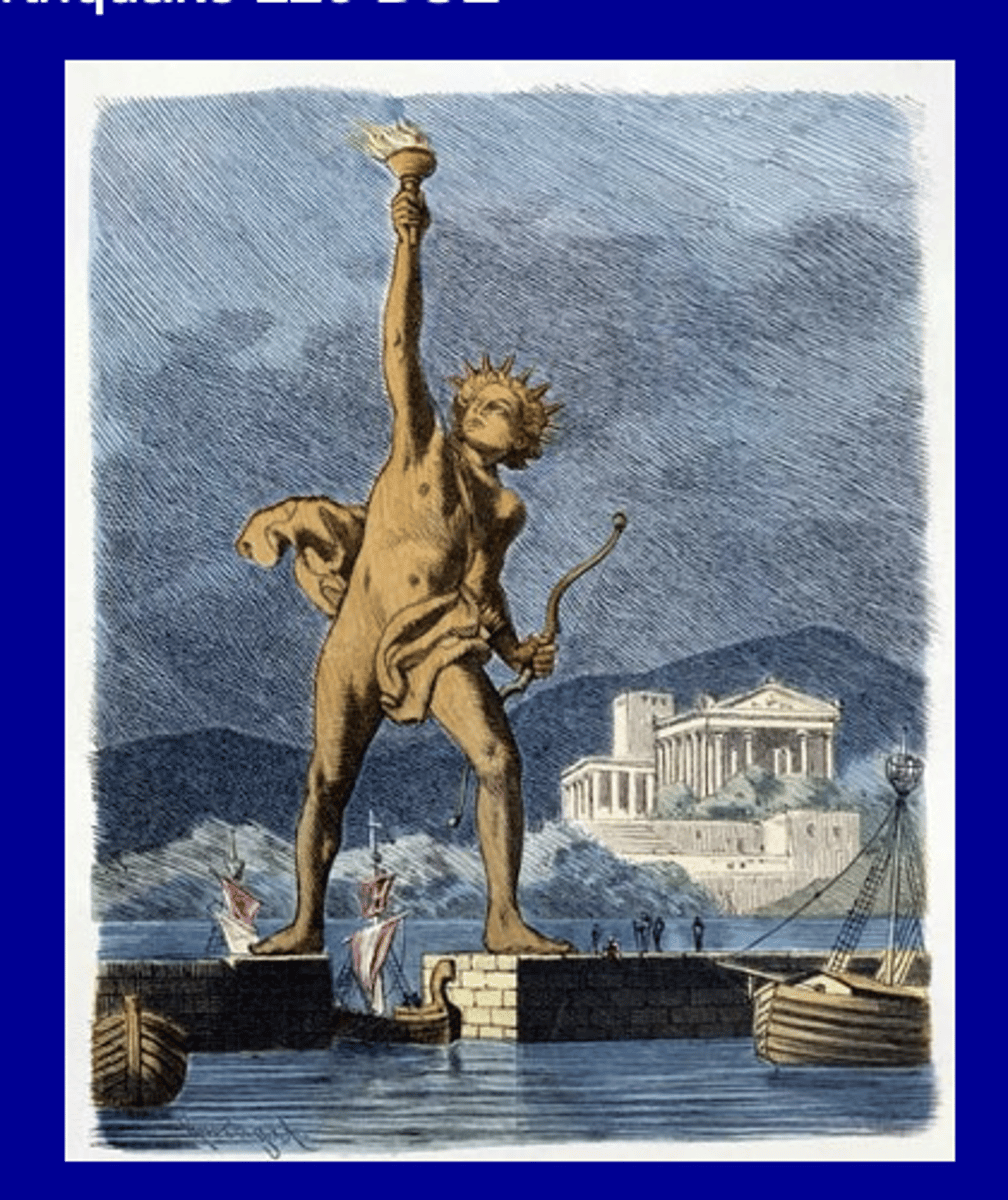
Chares of Lindos
sculptor who created the Kolossos of Rhodes, a student of Lysippos. Continued the art of colossal sculpture that Lysippos experimented with
Marble Head of Helios
from Rhodes ca. 200-150 BCE. Rhodes, Archaeological Museum
Siege of Rhodes
Demetrios I Poiorketes, 305 BCE.
Cessavit deinde ars
Pliny, Natural History, 35.51. States that between the year 296-293 BCE "the art stopped". Winckelmann thought it meant that art after the Classical period declined. sculpture stopped? Pliny's source ran out? "real" art stopped? THE (maybe) TRUTH: "The art (of bronze) stopped." BUT in 153 BCE (?), "Rursus revixit", the art of bronze "came back". Okay, Pliny.
Seleukos I
Macedonian general, one of Alexander's successors. Went on to establish the Seleucid Empire in Asia Minor, Mesopotamia, and the Iranian Plateau. Seleucid Empire was a MAJOR kingdom in the Hellenistic world
Tyche of Antioch
Vatican Museum. Roman copy of a (much bigger) bronze original created by Eutychides, ca. 300-290 BCE. crown shaped like fortified walls, holds grain in hands (symbolic of abundance and fertility), and is seated on a rock said to be Mt. Silipius. Swimming figure at her feet is the Orontes River. very Lysippan style, limbs all turned in different directions. Statue was raised above Antioch as a symbol of the city.
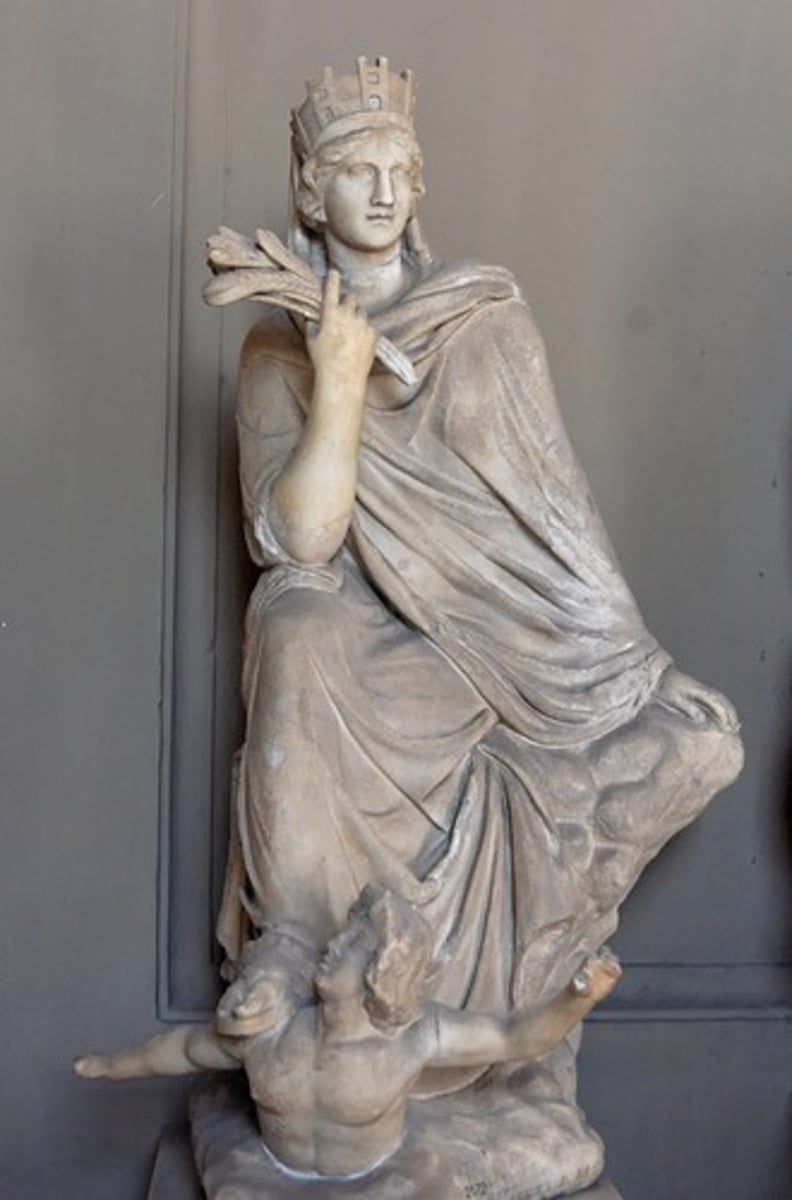
Eutychides
a student of Lysippos, bronze sculptor. created Tyche of Antioch ca. 300-290 BCE,
Themis of Rhamnous (Attica)
goddess of justice. pentelic marble statue from Rhamnous (Attica). made by sculptor Chairestratos. dedicated by Megakles. ca. 300-250 BC. National Archaeological Museum, Athens. wears himation and chiton, chord under breasts. knot at her stomach is bizarre, face is smooth and clasiscal. very static piece. may have been a cult statue due to Rhamnous being a cult center for Themis and Nemesis

Chairestratos
sculptor who created Themis of Rhamnous statue, ca. 300-250 BCE
Megakles
likely the patron of Themis of Rhamnous, inscription dedicates the sculture to him
Nemesis
goddess of revenge, vengeance, retribution. she and Themis had a cult center in Rhamnous
Tanagra, Tanagrettes
Town in Boeitia famous for its statuettes. These figurines depicted ordinary, middle class women. modest but fashionable dress. made in moulds made of wood or wax, often dedicated at sanctuaries. made of terrecotta and painted.
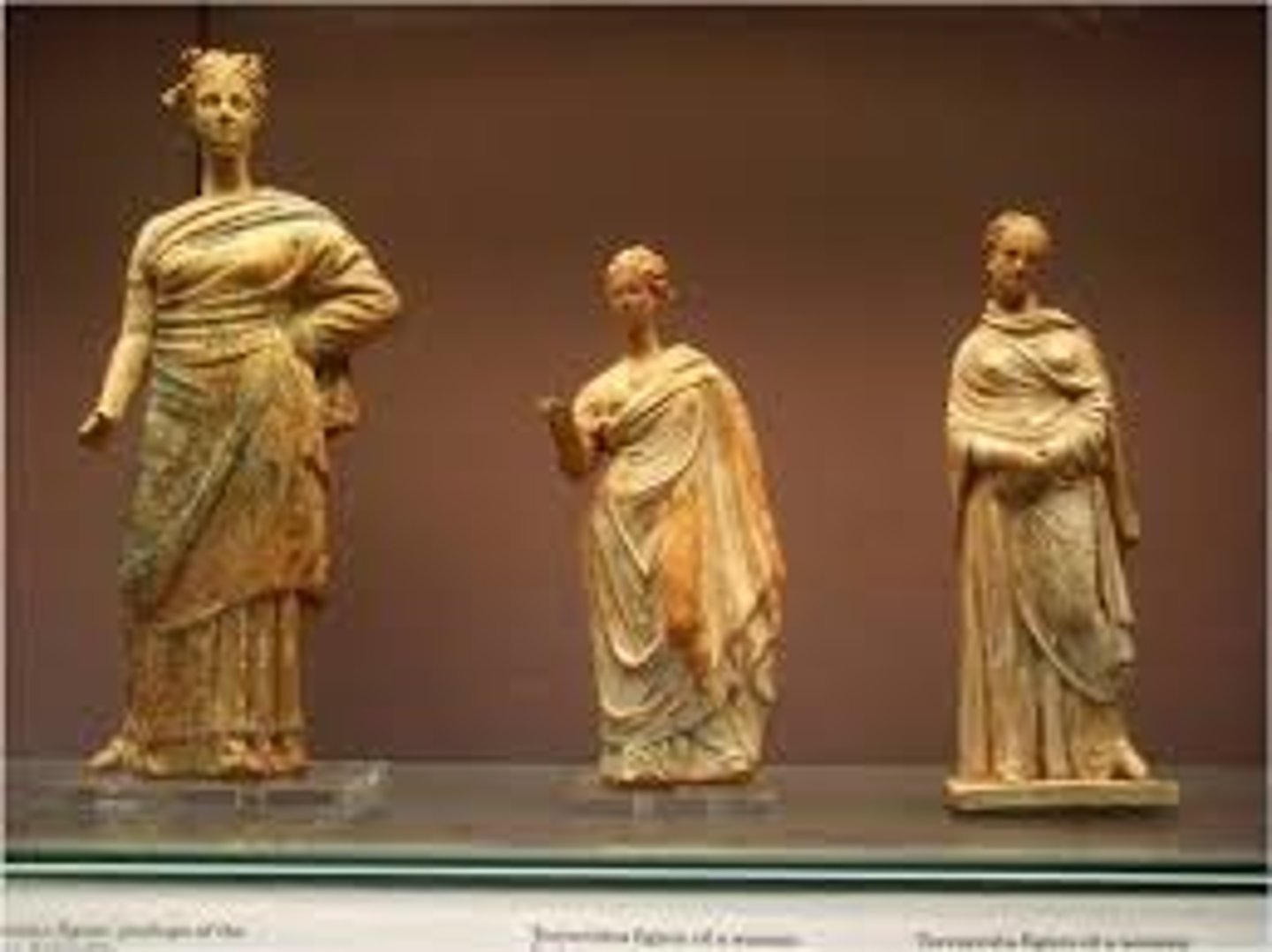
Seated Tanagra Statuette with apple
seated terracotta statuette of lady with apple. From Tanagra (Boiotia), Copenhagen, Ny Carlsberg Glypothek. Late 4th c. BCE.
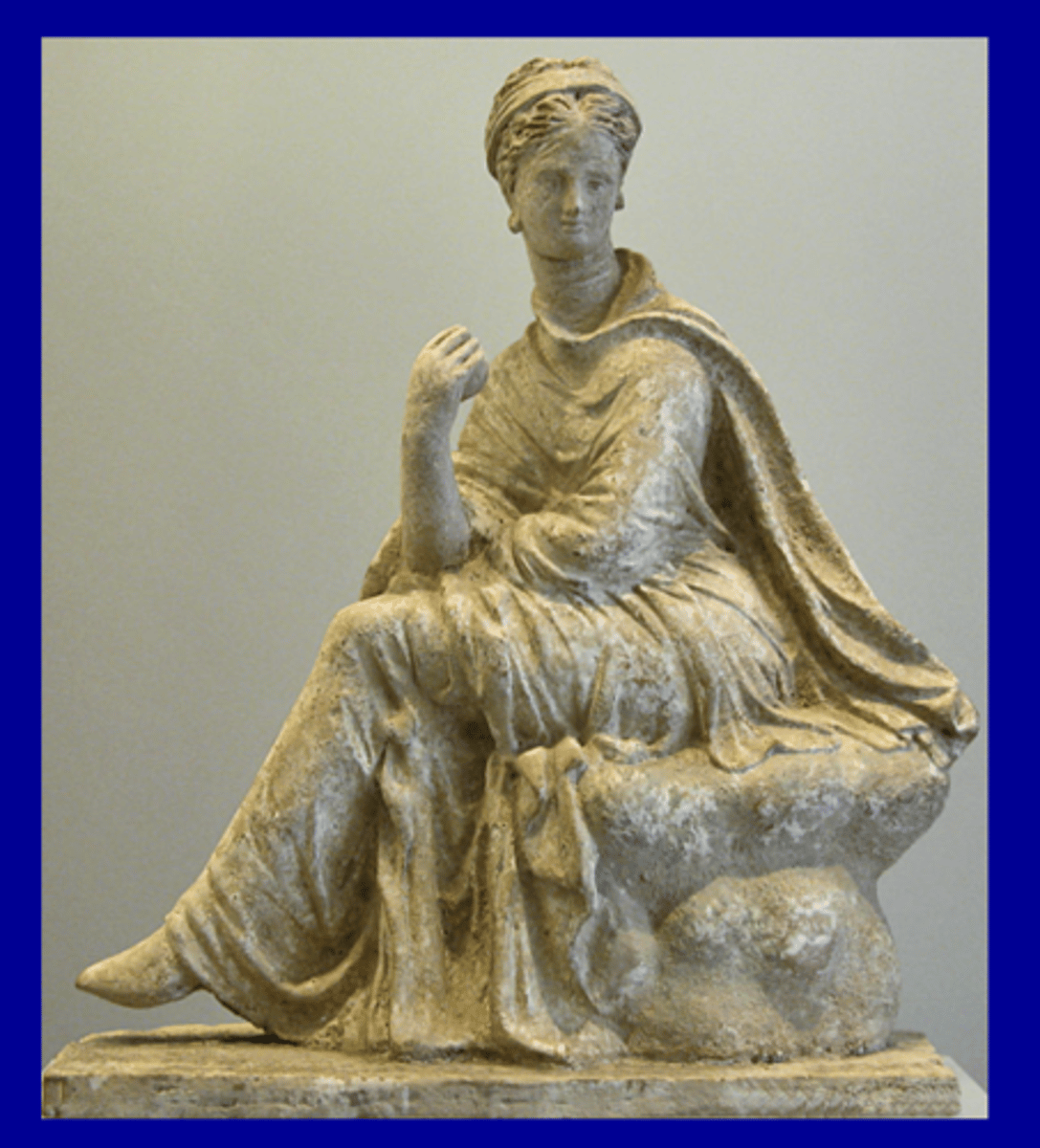
Tanagra statuette with hat
terracotta statue from Tanagra of standing woman with sunhat. ca. 3rd c. BCE. London, British Museum

Tanagra Aphrodite statuette w Eros
Terracotta Aphrodite playing with Eros from Tanagra. ca. late 4th- early 3rd century BCE. St Petersburgh, Hermitage Museum. Beautifully preserved pigment, holds a toy to play with her child.

Tanagra statue of two girls
two girls playing knucklebones. From Capua. London, British Museum.340-300 BCE.
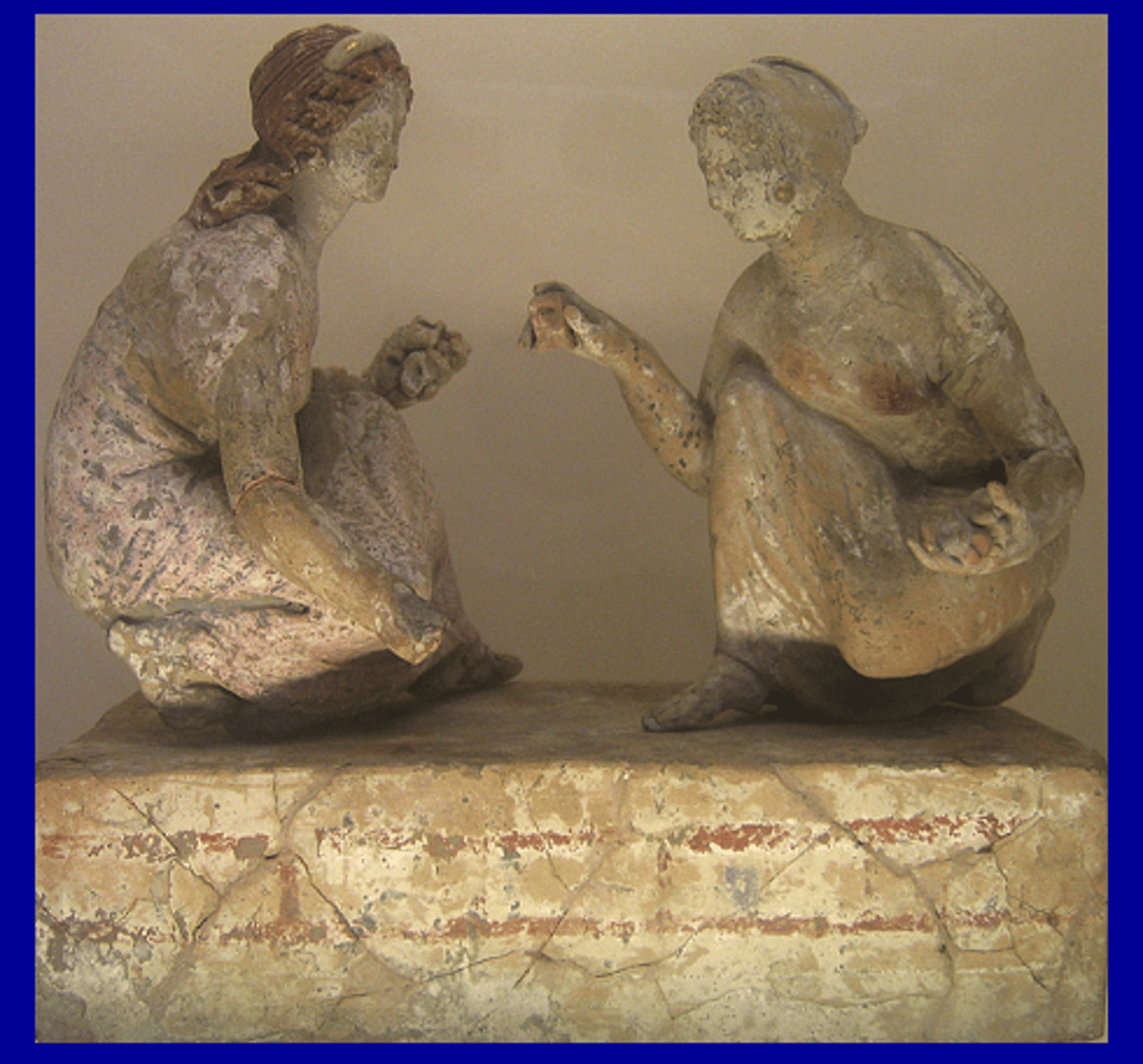
Boiotia
Region north of Athens. Thebes is here, as well as Tanagra
Sleeping Woman statue
Ariadne (?). Marble version, Vatican Museum, Vatican City. og ca. 3rd c. BCE
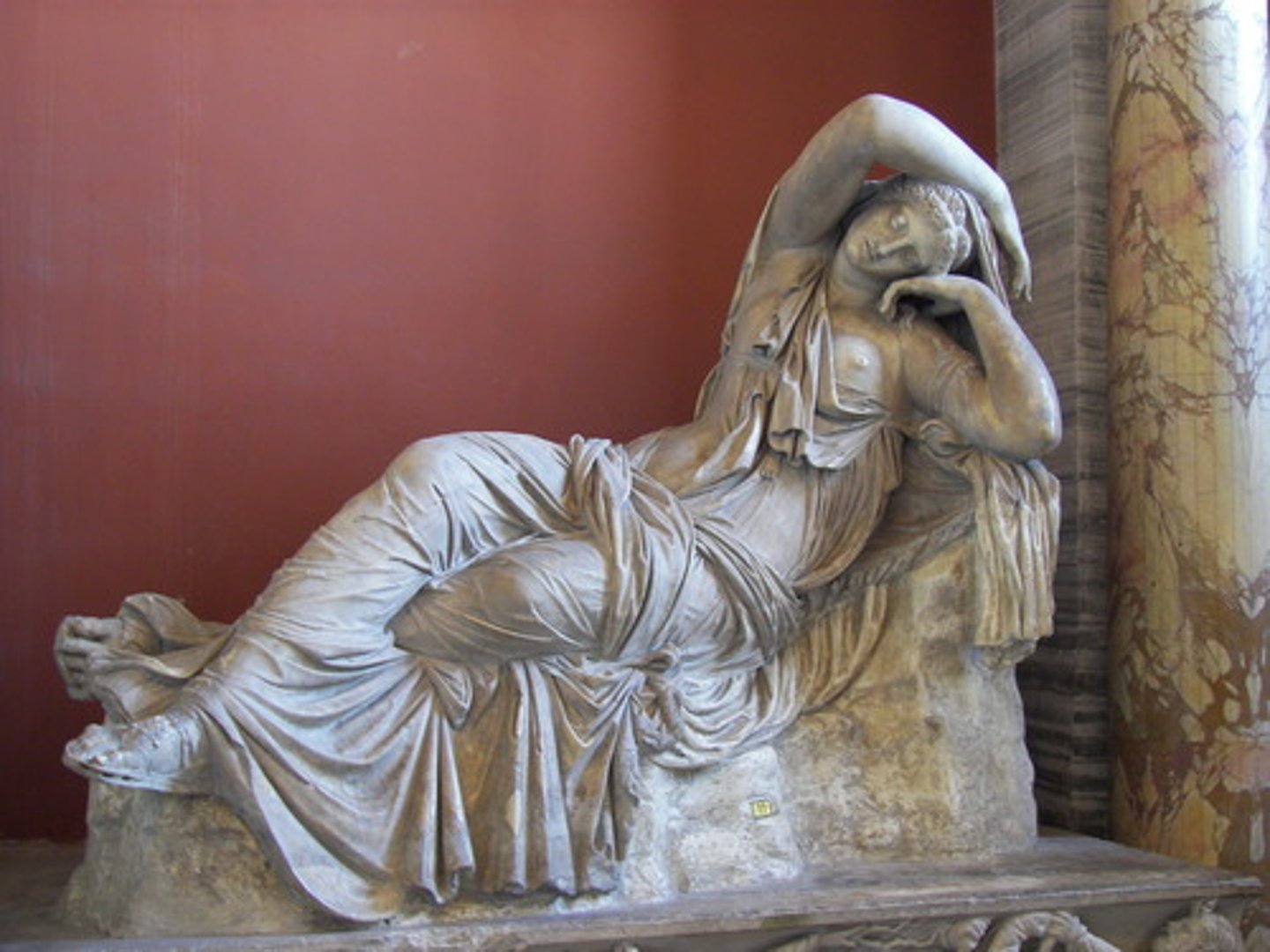
Head of woman falling asleep
marble, from South Slope of Acropolis, Athens. ca. 3rd c. BCE. Athens, National Museum

Hermaphroditos
son of Hermes and Aphrodite. took bath in Salmacis's river, she wished they would join forever and they did. Formed a person with both sex characteristics.
Sleeping Hermaphroditos Louvre
Marble, Roman copy. Paris, Louvre. original 3rd-2nd c. BCE. Mattress made much later by Bernini in 17th century. Sleeping is a very Hellenistic subject!

Sleeping Hermaphroditos Rome
marble Roman copy. Original attributed to Polykles. ca. 3rd-2nd c. BCE. Rome, National Museum of the Terme.
Salmacis
nymph who merged with Hermaphroditos to form one body
Polykles
created sleeping Hermaphroditos statue, ca. 3rd-2nd c. BCE
Sleeping Eros
bronze, ca, 3rd-2nd century BCE. NYC, The Met. stone base is modern.

Chaeronea 338 BCE
338 BCE, Phillip II invaded Greece, decisive Macedonian victory over the Greek allies ( Athens, Thebes, Corinth). One of the most important battles in history. Changed Greece forever
Perikles (d. 429 BCE)
Athenian statesman and a patron of the arts. funded the Parthenon. Roman copy of a herm/bust ca. 429 BCE. Vatican museum. 5th century style. identifiable due to inscription. mature, bearded, Corinthian helmet. formulaic, generic, godlike, nonrealistic.
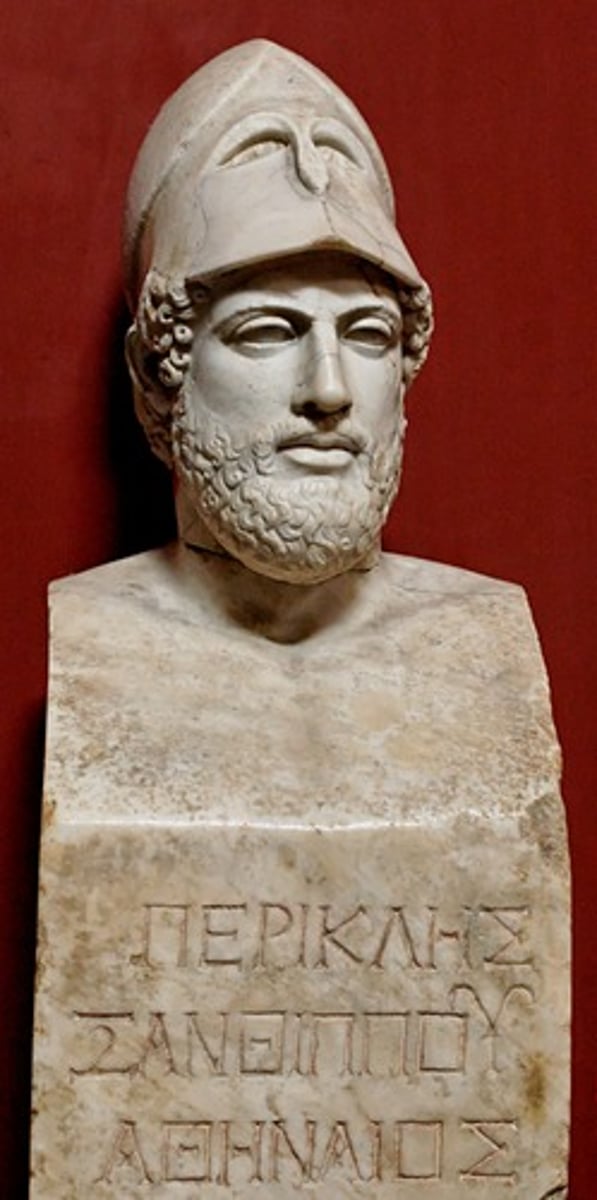
Kresilas
Greek sculptor in the Classical period, created a bust of Perikles. 5th century style.
Sokrates Head
annoying ass philosopher, killed in 399 BCE. Marble head of Sokrates. Roman copy of a Lysippos bronze ca. 340-320 BCE. Rome, Museo Nazionale Romano. Depicted as a balding man, shaggy hair, long beard. very Silenus-esque
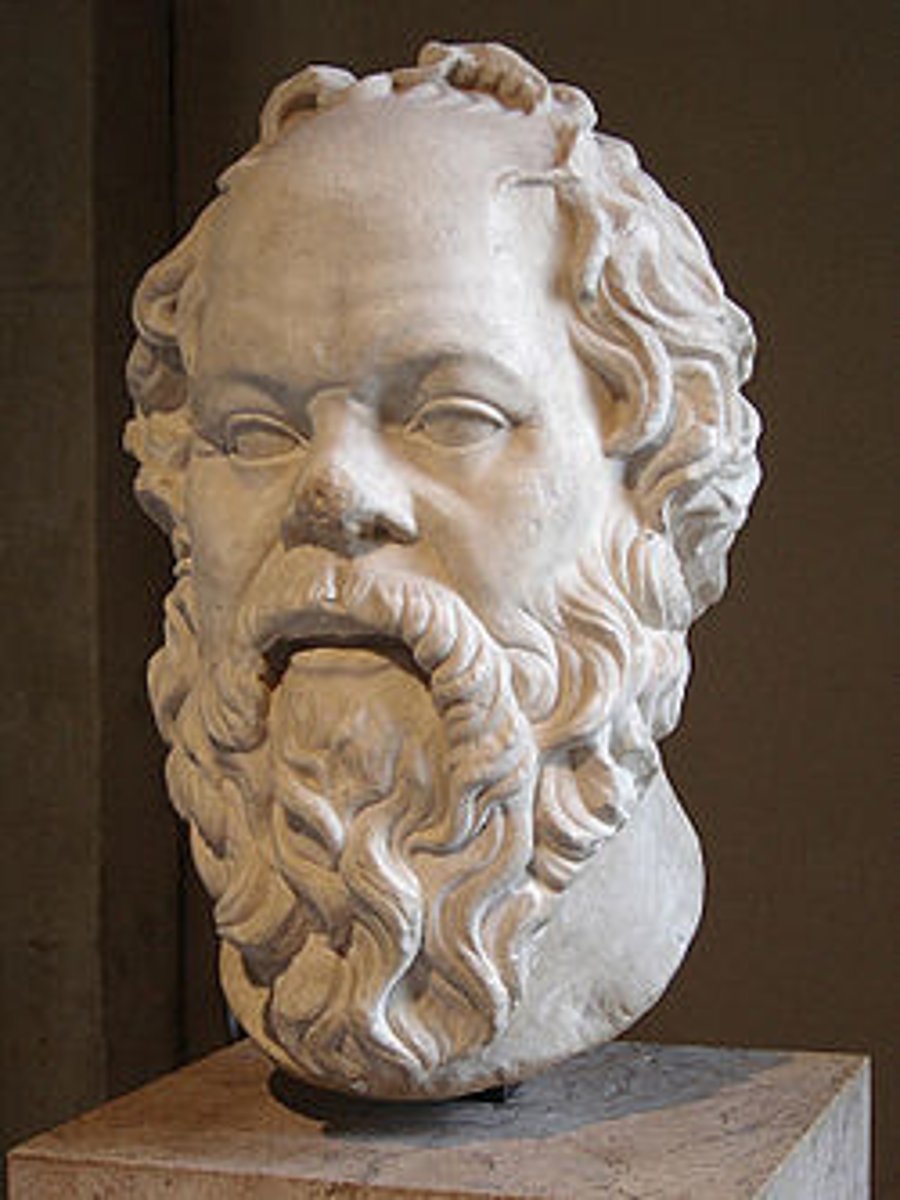
Sokrates Statuette
Roman copy in marble, based on Greek original ca. 4th c. BCE. London, British Museum. bald guy, Silenus beard. Wears a himation. old man body.

himation
An outer garment worn by the ancient Greeks over the left shoulder and under the right. common garment depicted in sculpture from the archaic through the Hellenistic period
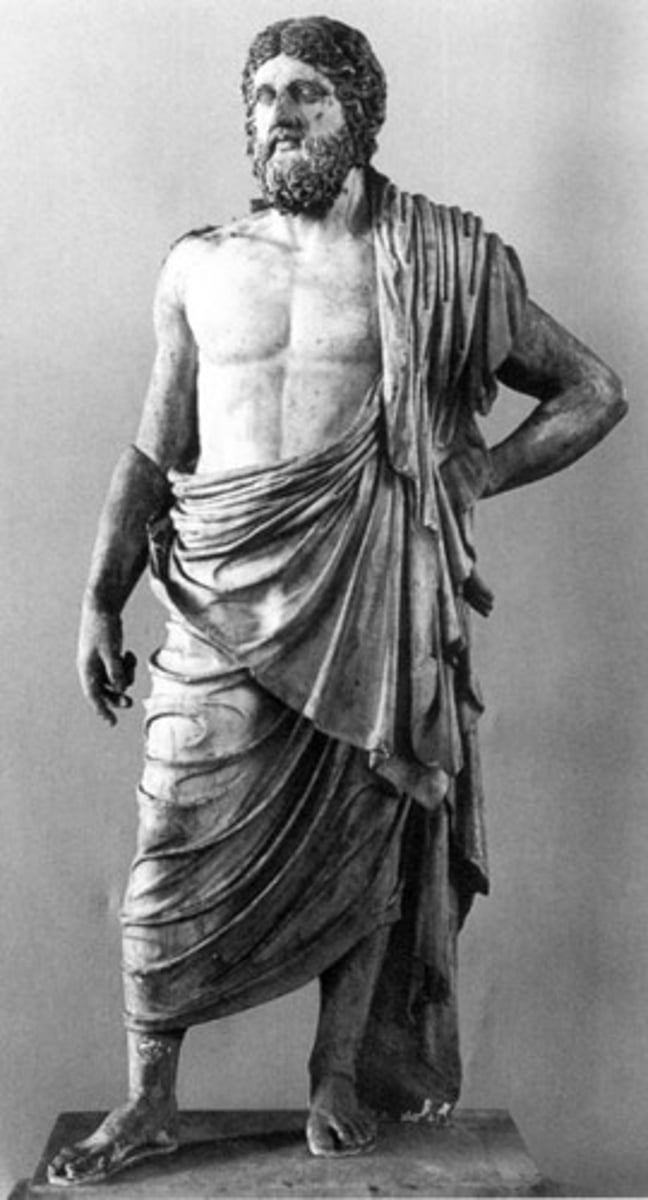
Aristotle (384-322 BCE)
Alexander the Great's tutor, a famous philosopher. set the tone for the love of libraries during the Hellenistic period. skinny legs big gut. spoke with a lisp.
Aristotle head
Marble Roman copy, ca. 330 BCE. Vienna, Kunsthistorisches Museum. flat head, shaggy-wavy hair. wrinkled forehead, brow. full beard. May have been part of a herm.
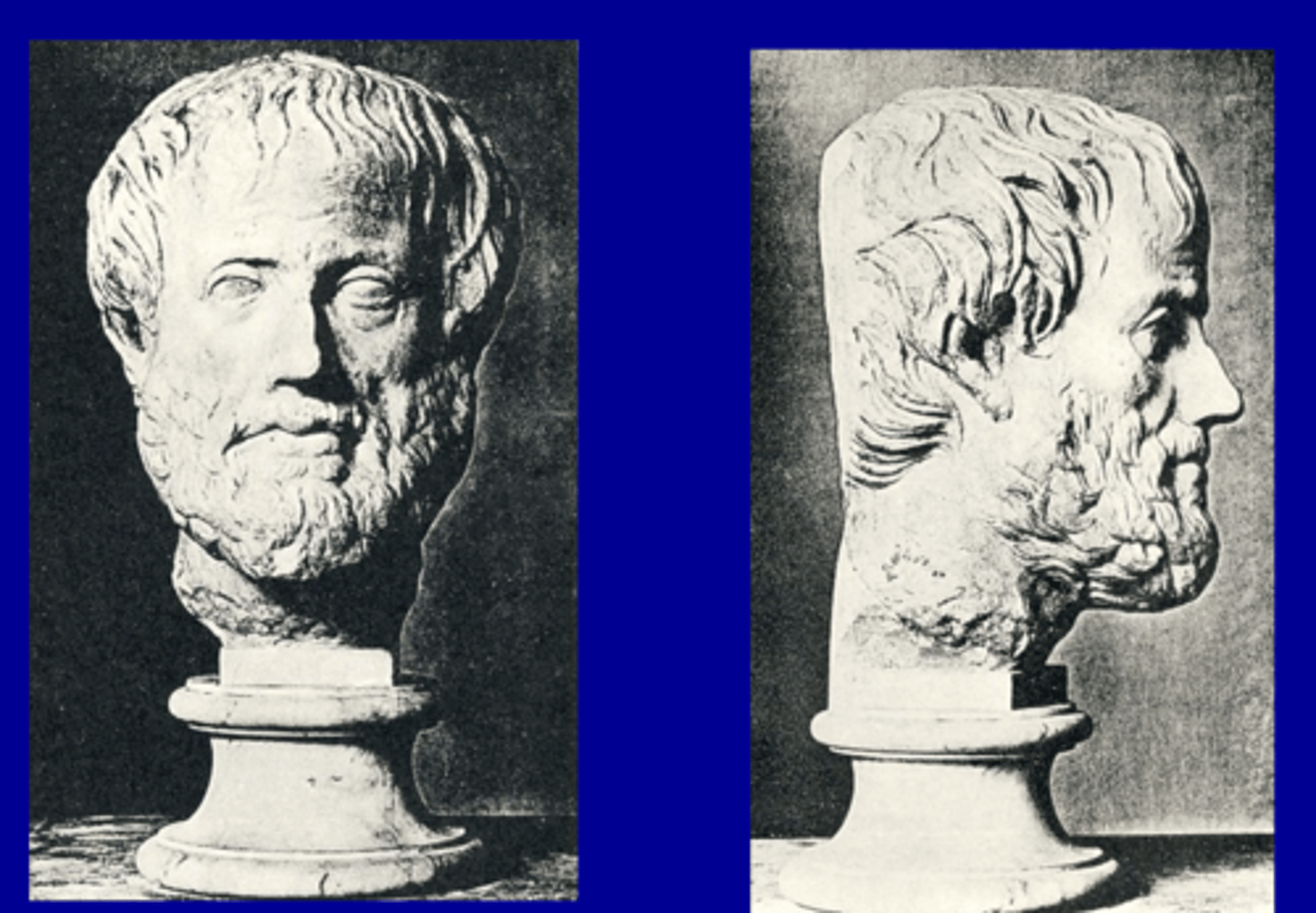
Bronze Aristotle Portrait
copy from Roman period, found in the Villa of the Papyri, Herculaneum. Naple, Archaeological Museum. original ca. 330 BCE. Appears very serious, furrowed brow, eyes cast down. old man thinkin
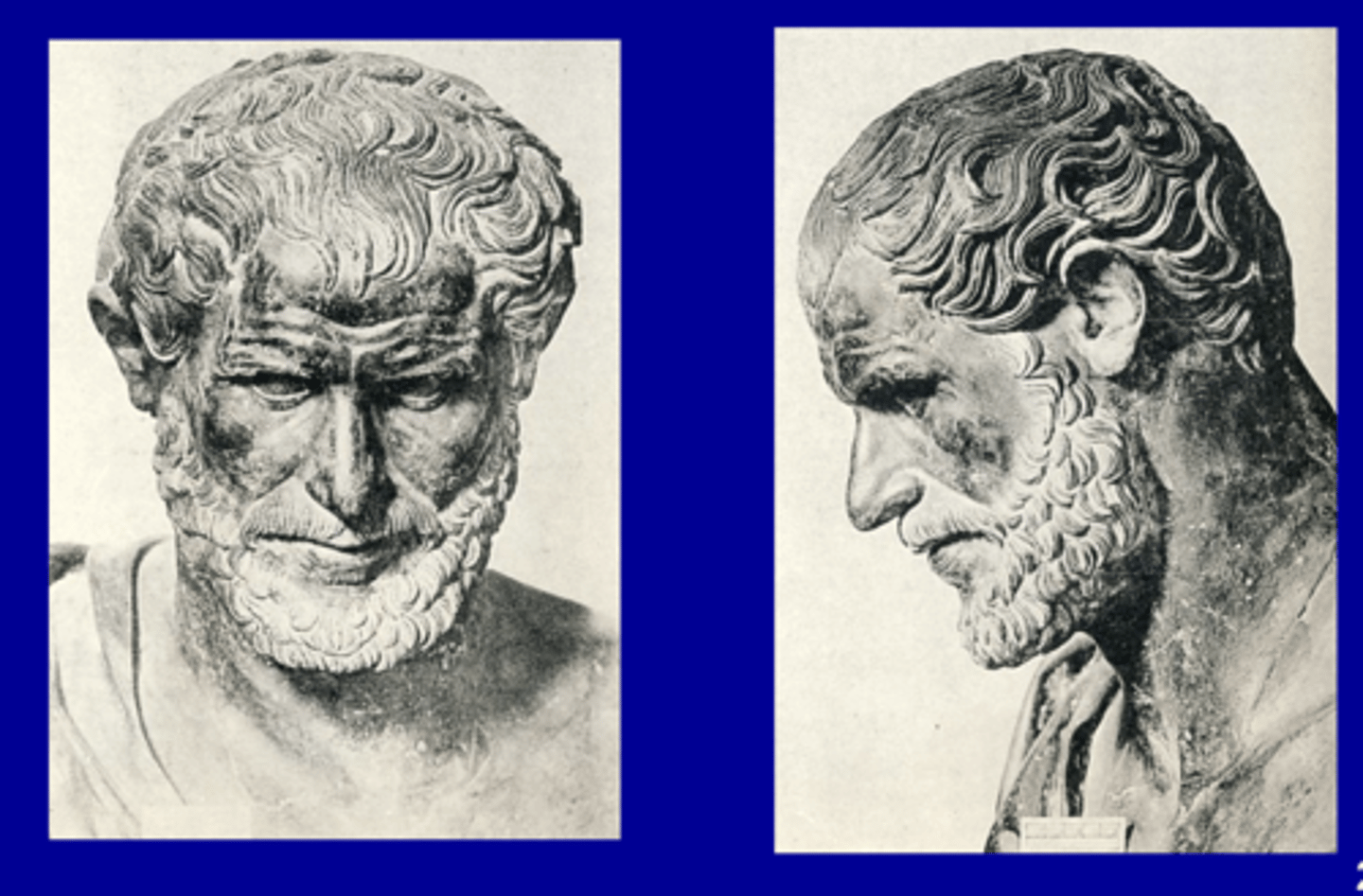
Lyceum
Artistotle's school! recall the painting by Raphael
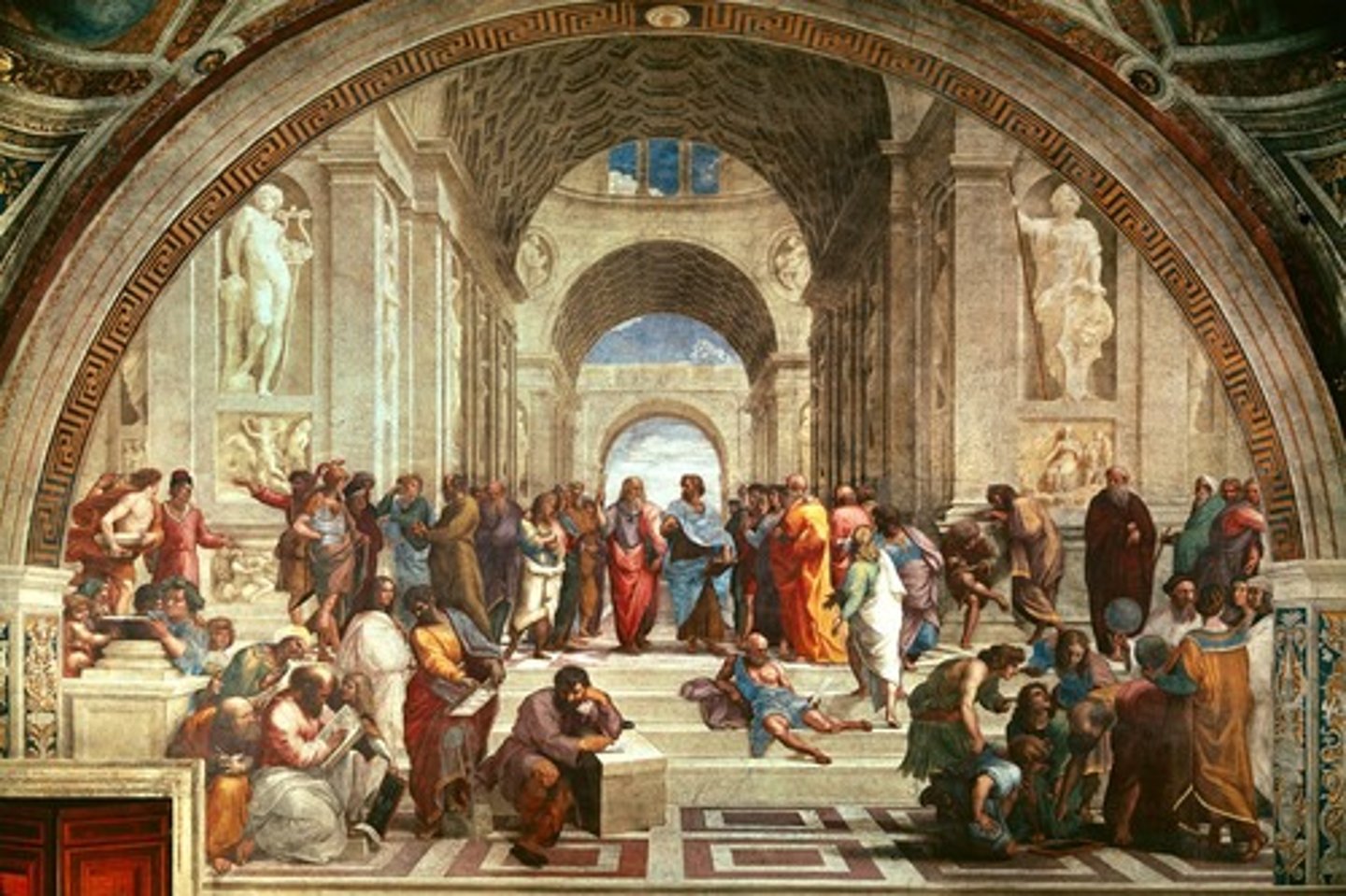
Demosthenes (384-322 BCE)
Greek statesman and orator, spoke w pebbles in his mouth
Demosthenes Marble statue
Copenhagen, Ny Carlsberg Glyptotek. Roman copy of original ca. 280 BCE, attributed to Polyeuktos. ca. 50 replicas of this statue exist. was set up in the Agora. wears a himation, deep in thought, pondering. stands w his fingers interlaced.
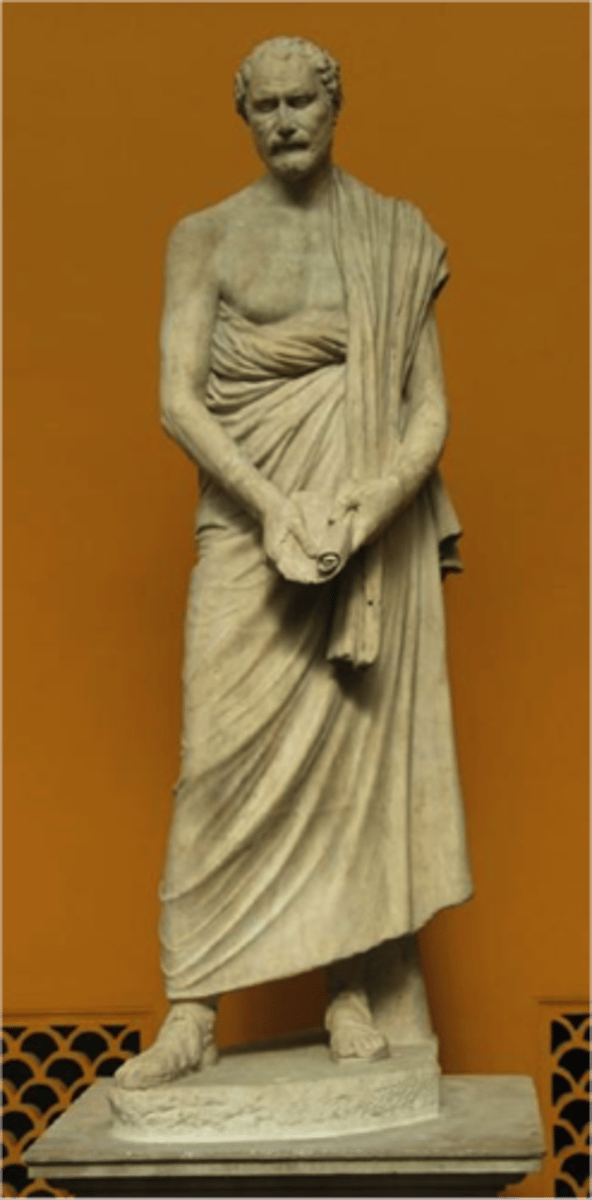
Demosthenes Marble head
New Haven, Yale University Art Gallery. Roman copy. wrinkly ass face, receding lower lip (maybe eating pebbles idk). Balding like a philosopher.
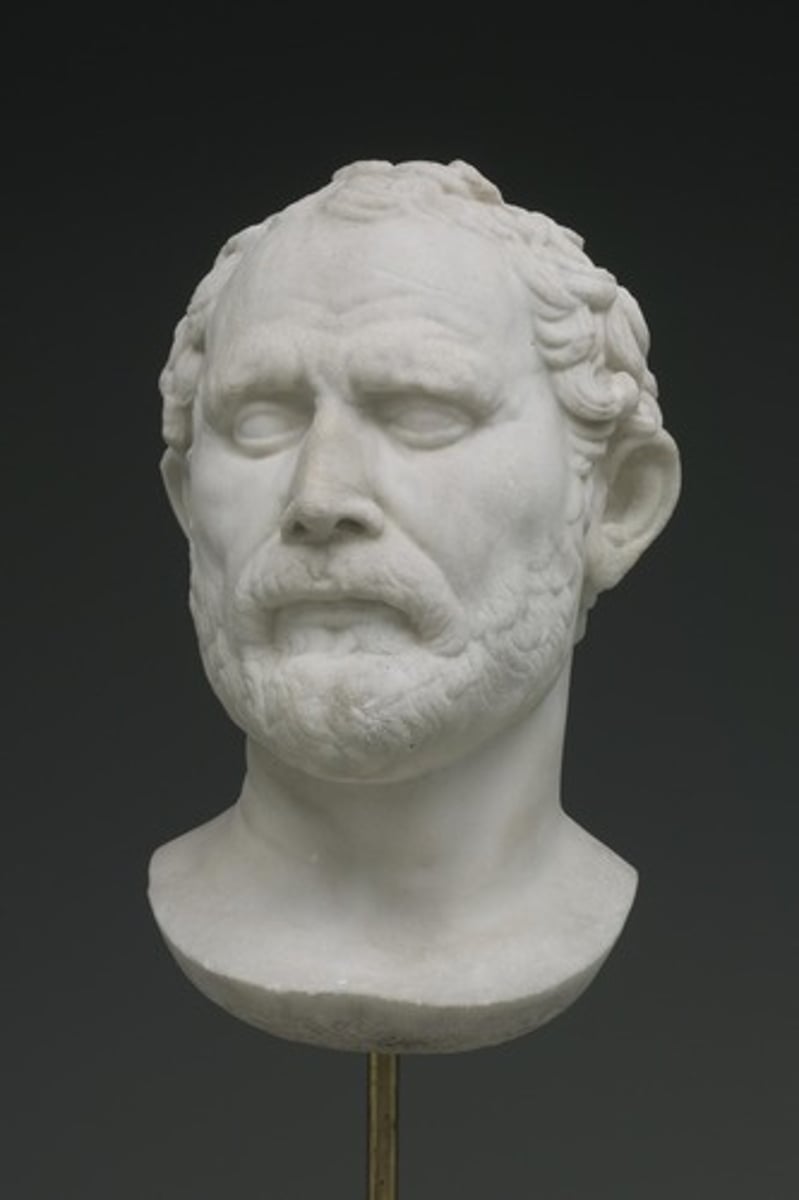
Polyeuktos
bronze sculptor, created Demosthenes statue ca. 280 BCE
Epikouros (d. 270 BCE)
philosopher who pioneered Epicureanism. founded his own school in Athens called "the Garden".
Epikouros Marble bust
herm. Rome, Capitoline Museum. Roman copy. original ca. 3rd c. BCE Very messy, wavy hair. Very serious thinking face, brow furrowed.
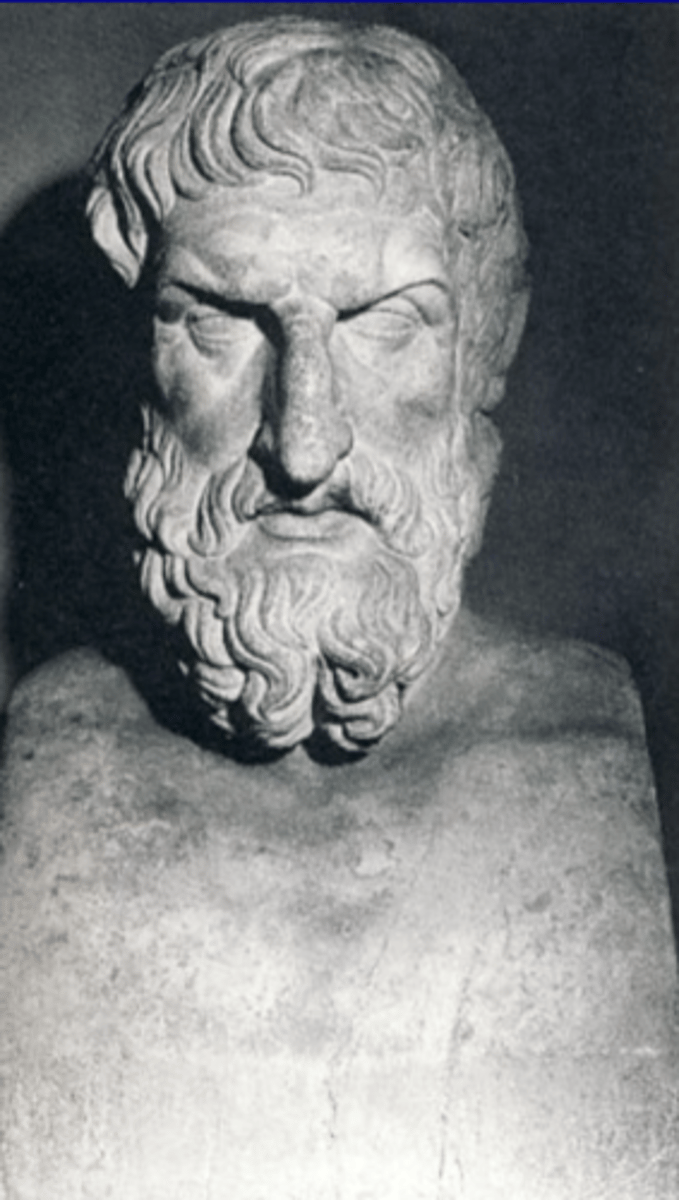
Epikouros marble head
NYC, The Met. Roman copy of Greek OG. ca 3rd c. BCE. again, messy hair, eyebrows kinda arched, etc.
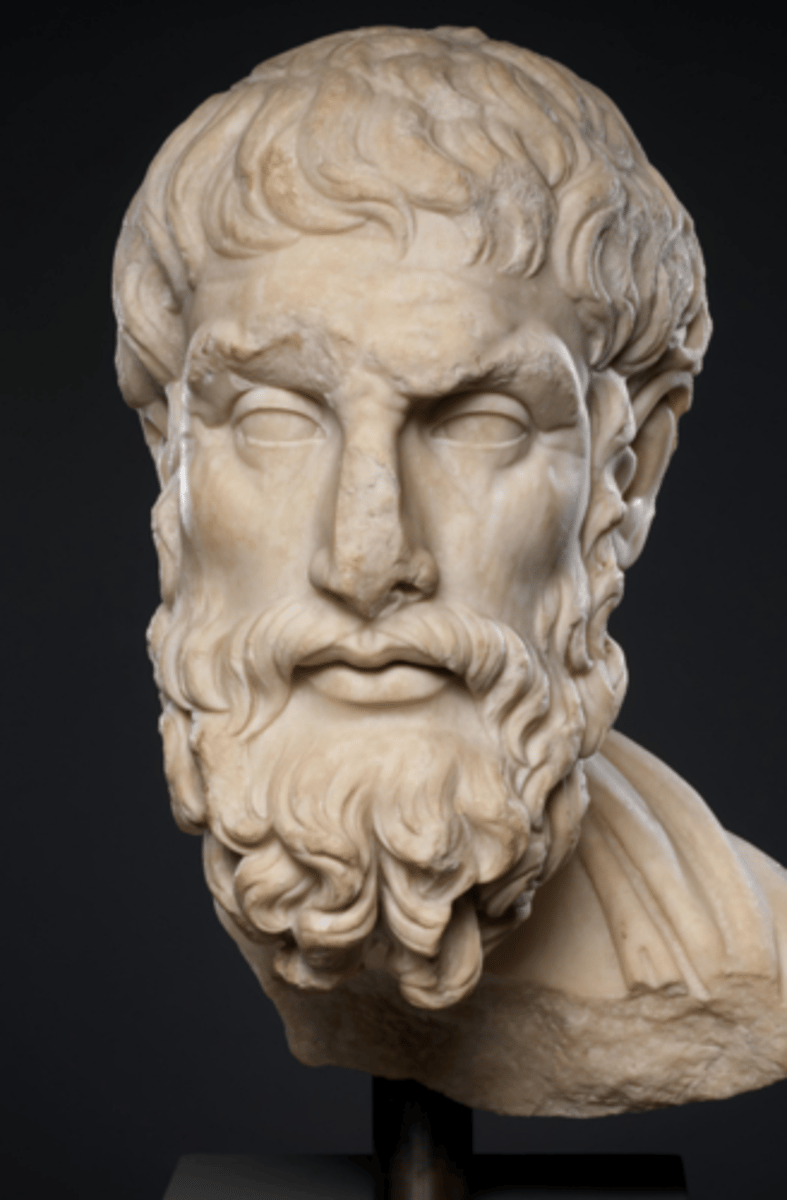
Epicurus/Epicureanism
school of philosophy that emphasized that pleasure is achieved through the avoidance of pain
Antisthenes (d. 360 BCE)
cynic philosopher (word cynic comes from κύων, meaning 'dog').
Antisthenes bust
attributed to Phryomachos, Roman copy, original ca. 3rd century BCE. Vatican museum. furrowed brows, thick long beard, wavy, stringy hair. very philosopher looking. rich, baroque style
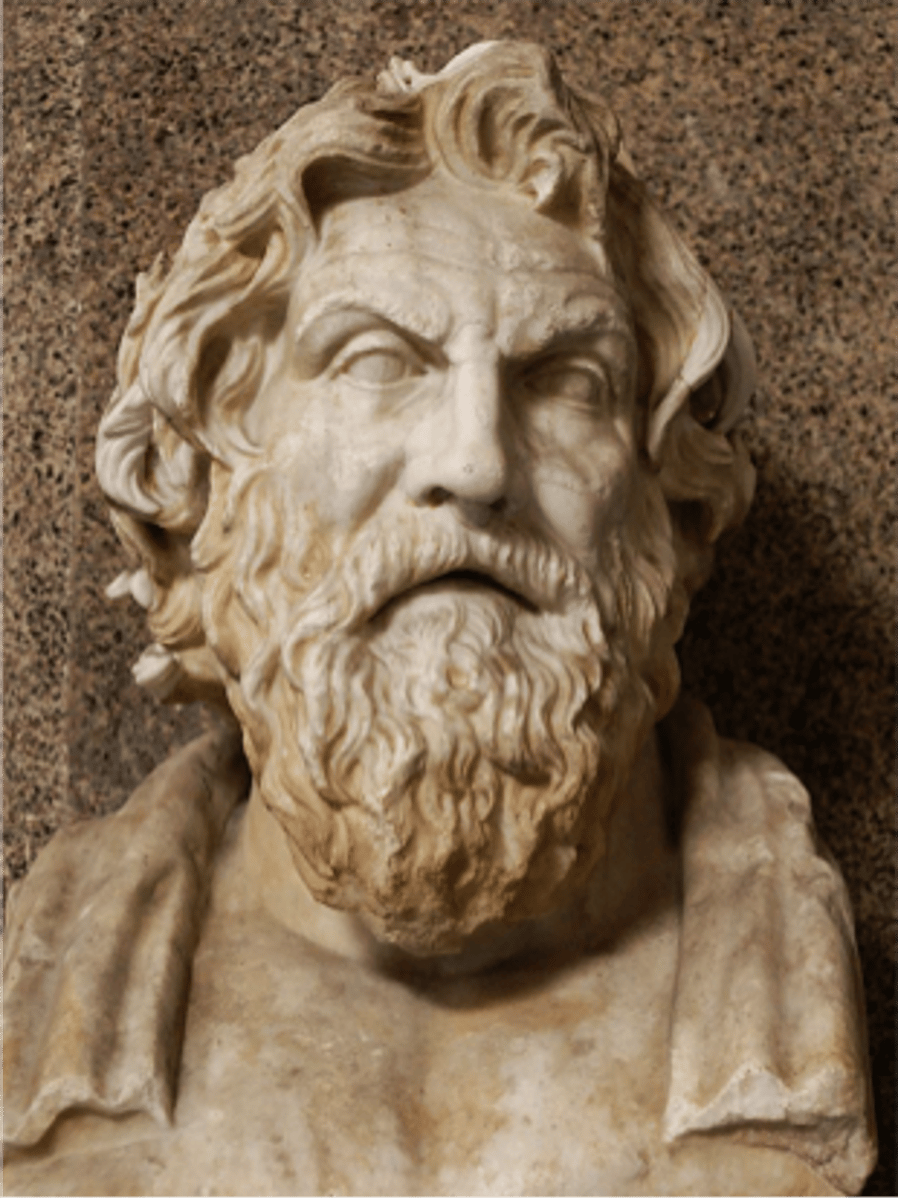
Antisthenes (?) Head of Philosopher
found in Antikythera shipwreck. Athens, National Archaeological Museum. ca. 3rd century BCE. bronze statue with the original, creepy eyes

Phyromachos
sculptor who made Antisthenes bust
Bronze statuette of Philosopher
og ca. 250-200 BCE, Roman copy. New York City, the Met
Chrysippos (d. 206 BCE)
stoic philosopher, very important to the development of Stoicism
Chrysippos head
Roman copy. London, British Museum, ca. 3rd century BCE. Furrowed brow, very much resembles the Antisthenes bust, so do beware! He's bald(ing), crazy ass hairline. bearded, furrowed brow, gazing into the distance. stoic philosopher.

Chrysippos marble statue
Body in Paris at the Louvre, attatched plaster copy of head in British Museum.

Marble Homer head
ca. 2nd c. BCE, Roman period copy, Boston Museum of Fine Arts.
Rembrandt
Aristotle Contemplating the Bust of Homer, NYC, The Met, 1653
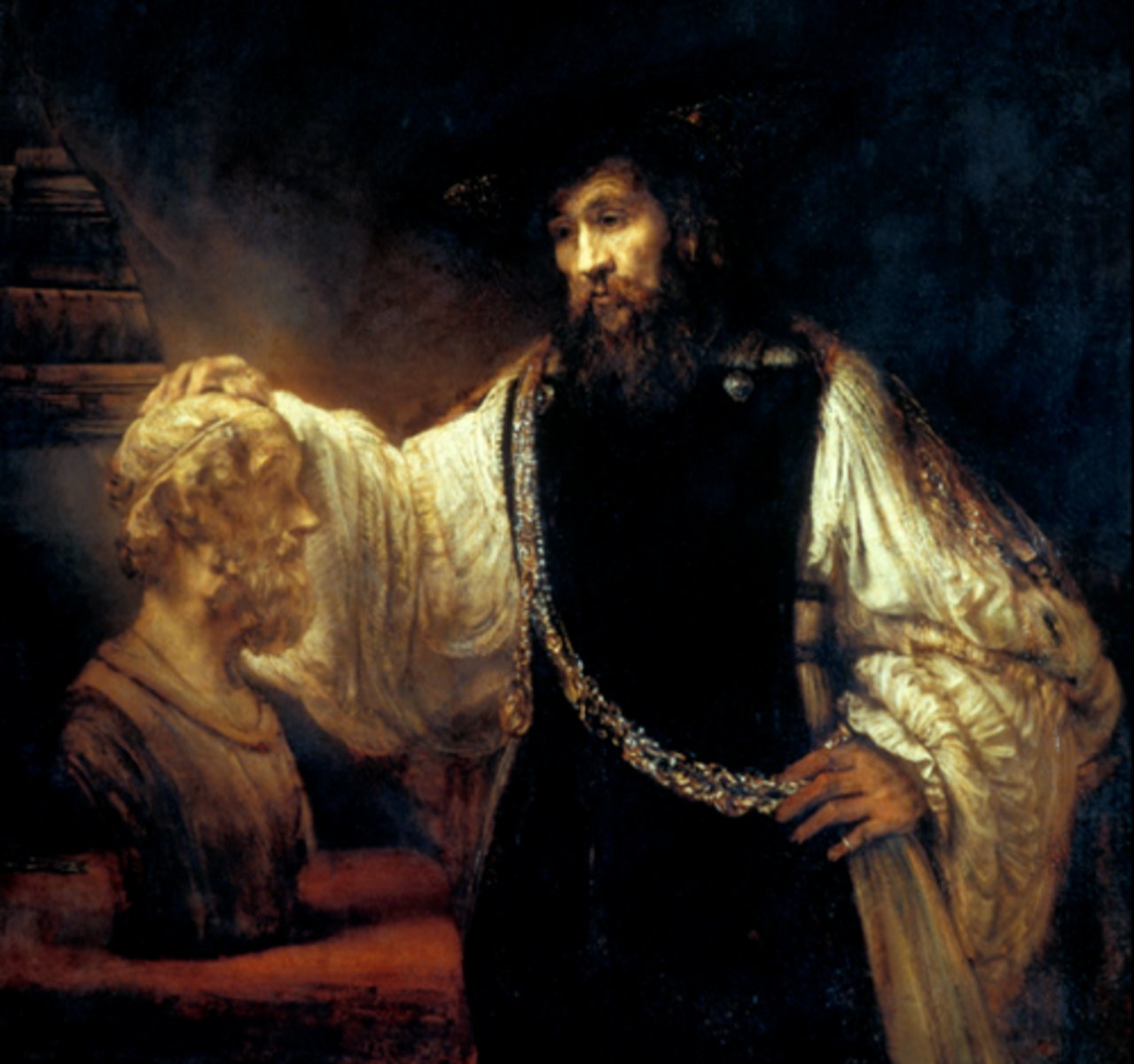
Asklepios
god of medicine. Bronze Pergamon coin depicts the god in profile on one side, full body (statue) of the god on other. Statue attributed to Phryomachos. ca. 190-150 BCE.
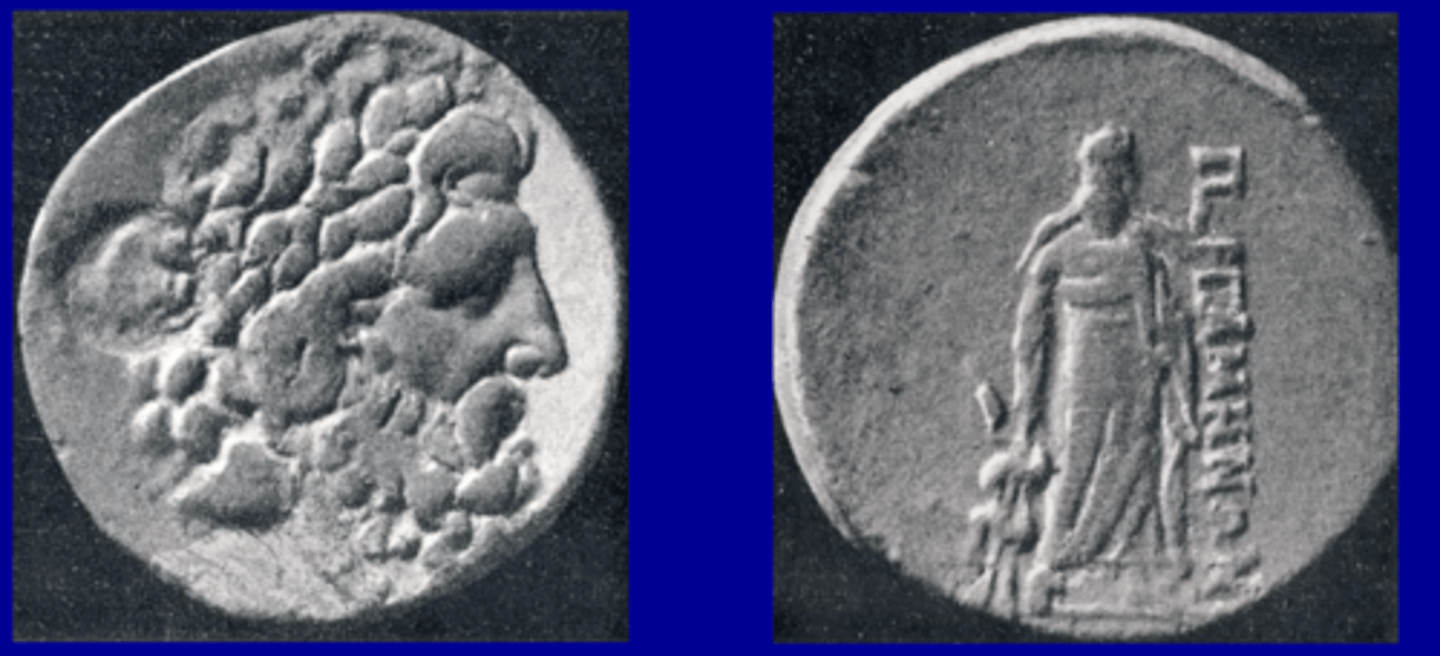
Antikythera
island b/n Crete and Peloponnese, famous shipwreck. MANY things found, including that one controversial device.
Menander (ca. 342-289 BCE)
Famous Hellenistic writer, ushered in the era of New Comedy. most of his works don't survive, but do survive in quotes. inspired Plautus and Terrance
Marble Menander Bust
Pentelic marble bust, attributed to Kephisodotos and Timarchos. ca. 289 BCE, Roman copy, MFA Boston. Short hair, gazing into the distances, strong nose

Other Marble Menander Bust
Roman period copy, Venice, Seminario Patriarcale. 60+ replicas of this one
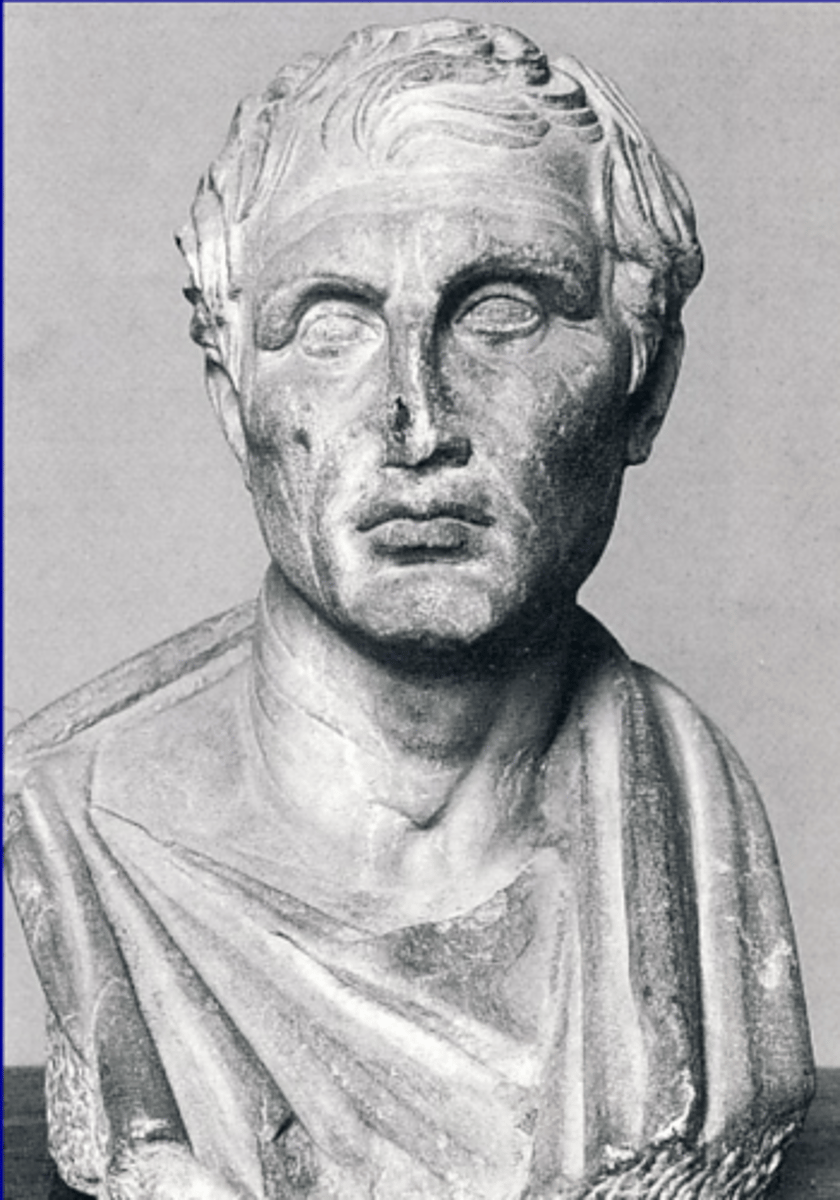
Double Herm
Controversy over the identity of the second person on herm, as to weather it's Homer and Menander or Homer and Virgil. Rome, Palazzo Massimo. Roman copy of Hellenistic original.

Marble Menander Medallion
drawing by Theodore Gallaeus, 1578. Piece was once in the collection of Fulvio Orsini, Rome
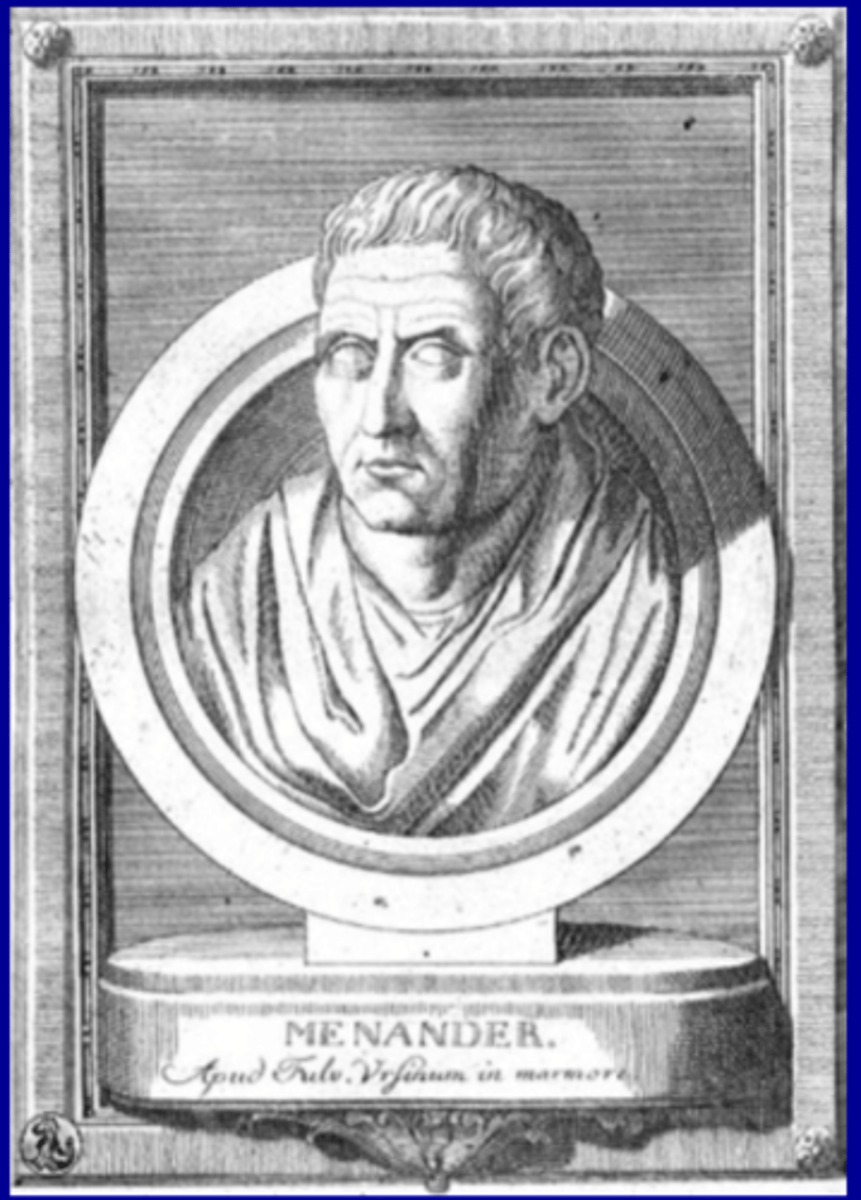
Bronze Menander bust
Name inscribed to identify as him. bronze Roman copy. Malibu, Getty Museum. patina on the bronze makes it look old and collectors eat that shit up

Kephisodotus and Timarchos (fl. 310-290 BCE)
the sons of Praxiteles. sculptors. created bust of Meander, Pentelic marble., Roman copy, ca. 310-290 BCE. Boston, Museum of Fine Arts
Demetrios I Poliorketes (294-288 BCE)
The "city seiger", awesome name. King of macedon from 294-288 BCE. Ruled many of the lands that Alexander took. Dashing, theatrical ruler, but also a good general and very smart.
Demetrios Bust
Naples, Archaeological Museum. Found in Villa of the Papyri, Herculaneum. Roman copy. original ca. 290 BCE. no beard, smooth and youthful face
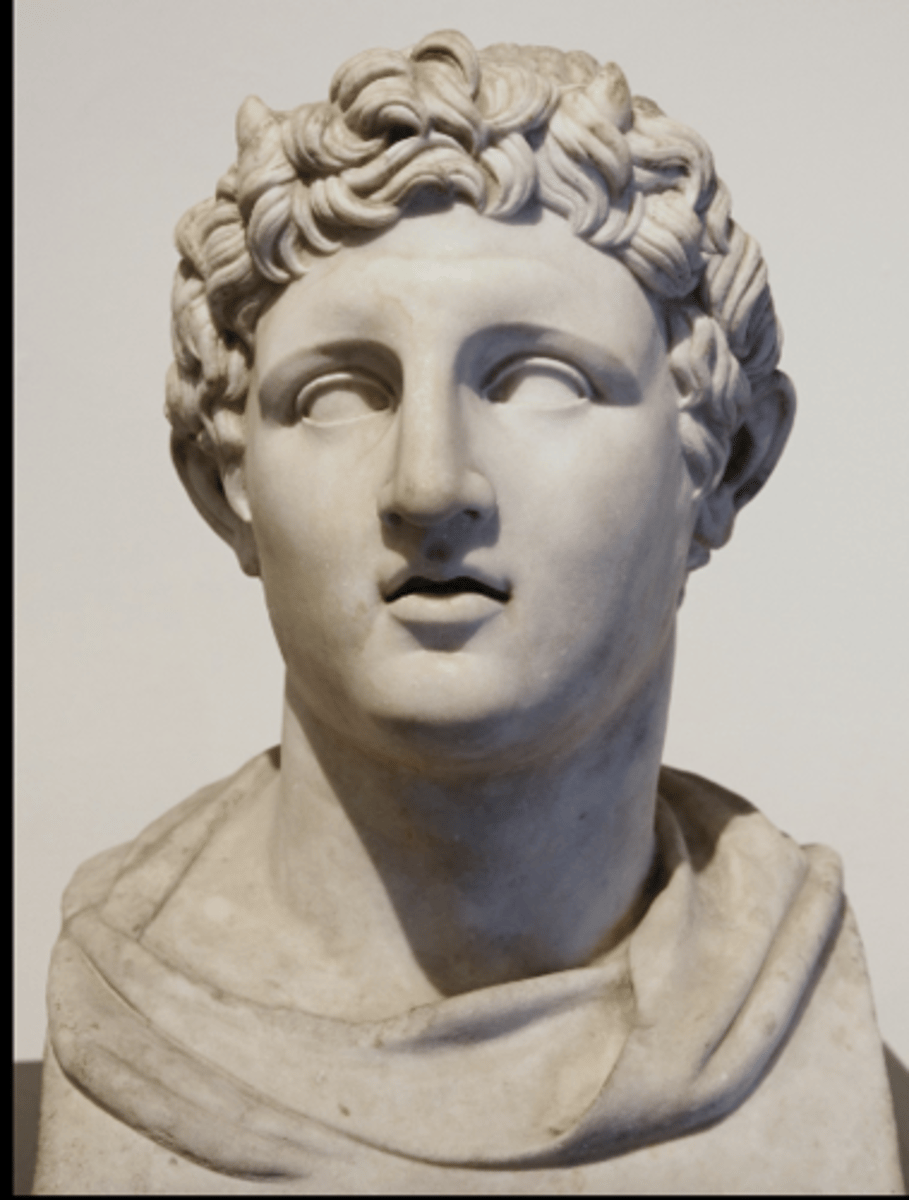
Silver tetradrachm of Demetrios
depicted with horns, like Alexander. claims lineage of poseidon so hes on the back of coin. ca. 290-289 BCE
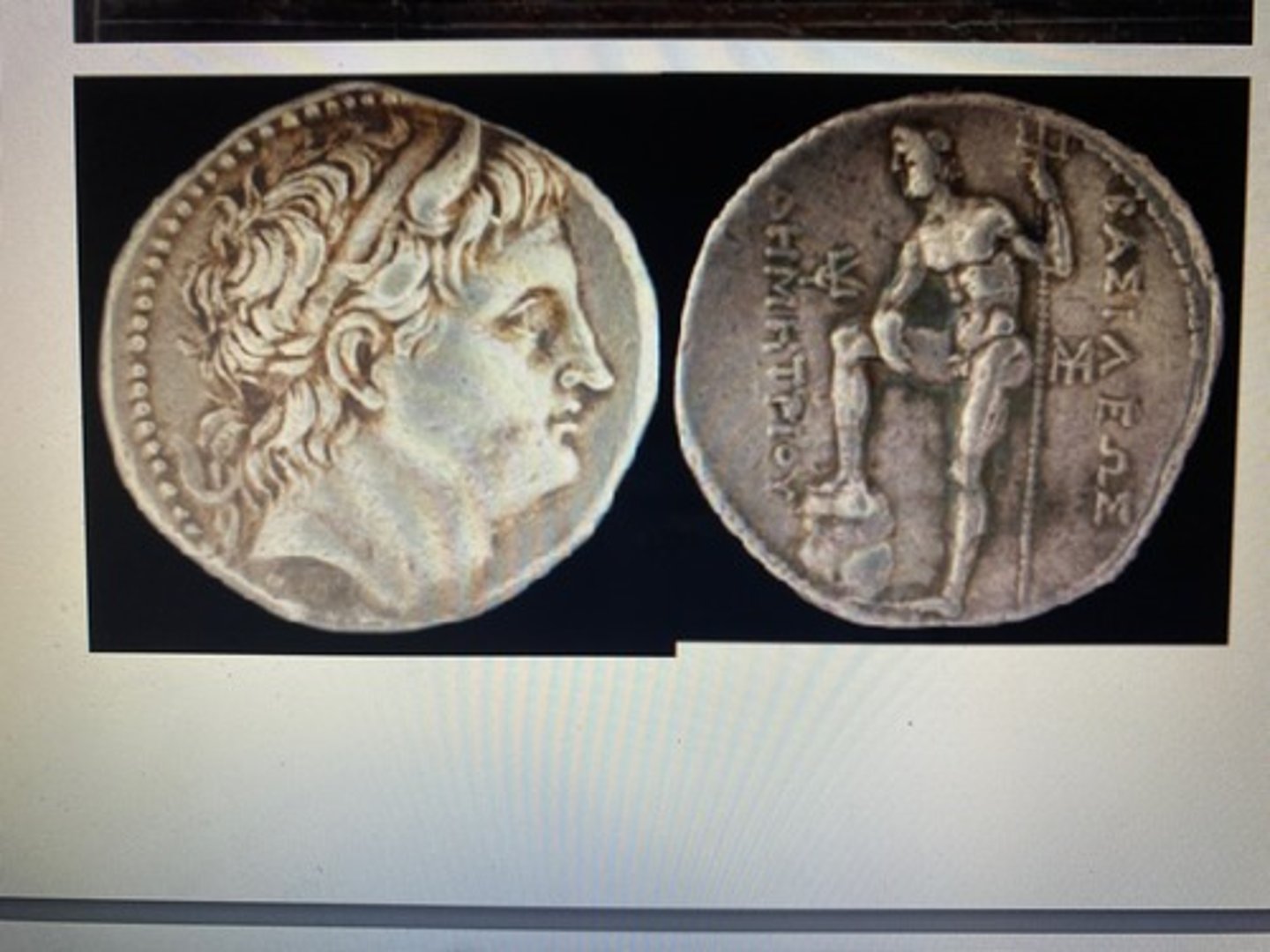
Statuette of Demetrios
Naples, Arch. Museum. Villa of the Papyri, Herculaneum. bronze copy statue, original ca. 290 BCE. one leg up, relaxing pose. young commander. smooth, youthful face
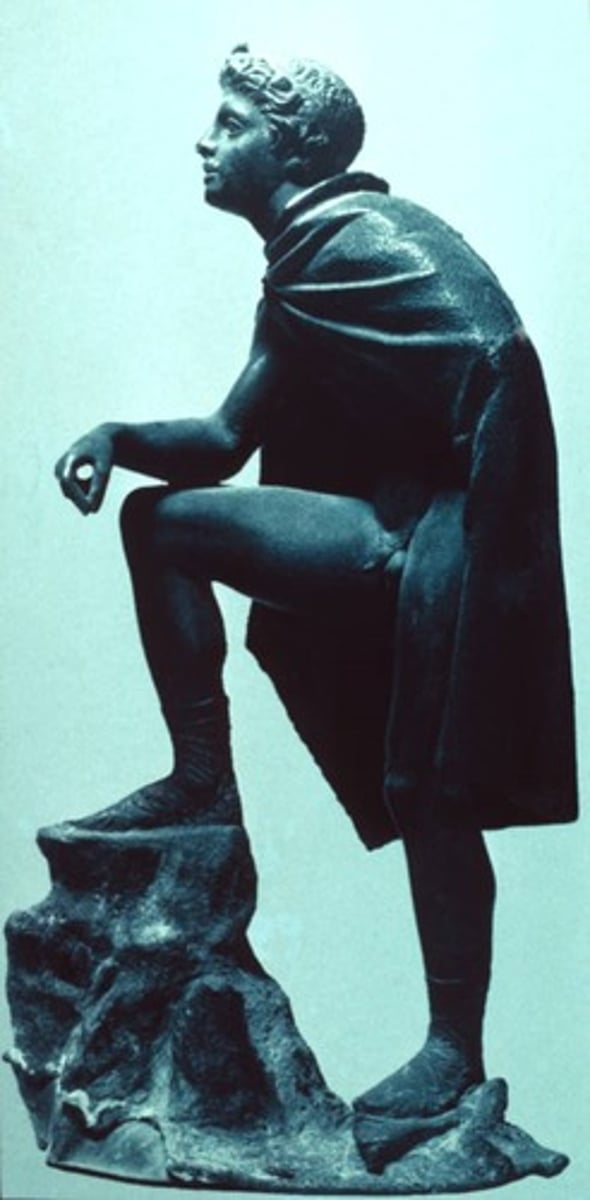
Rulers of Macedon
Phillip II (360-336); Alexander III the Great (336-323); Phillip III (brother of AtG) (323-317); Alexander IV (son of AtG) (323-310); Cassander (AtG's backstabbing buddy) (310-297); Demetrius I Poliorketes (294-288); Lysimachus of Thrace (One of AtG's generals) (287-281)
The Diadochoi
Alexander's successors. Macedon=Cassander; Thrace=Lysimachos; Egypt=Ptolemy; Asia=Antigonos the One Eyed and Seleukos; Pergamon=Philetairos, Attalos
Tomb of Alexander the Great
331- Alexander's visit to oasis of Siwas and oracle of Zaues Ammon. Founding of Alexandria; 323- Alexander dies at Babylon; 322/321- funeral carriage of Alexander, on its way to Aigai, hijacked by Ptolemy I; 321/320- Ptolemy I buried Alexander at Memphis; ca. 280 BCE- Ptolemy II Philadelphod transferred burial to Alexandria; later placed in communal mausoleum called the Sema/Soma